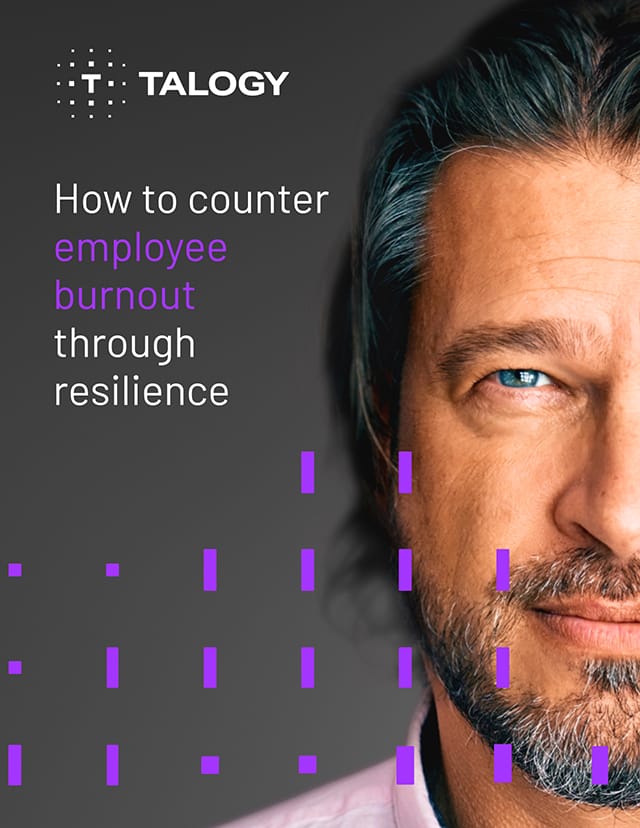Written by Ali Shalfrooshan, Head of International Assessment R&D
Building and maintaining resilience in the workplace is the key to overcoming employee burnout — a major issue affecting the modern workforce. Discover different ways organizations can learn how to build resilience at work to help their employees overcome burnout and enhance their overall well-being to improve productivity at work, even in the midst of new challenges.
The signs and impact of employee burnout
Employee burnout is an all-too-common issue that affects professionals everywhere across all industries, departments, and roles. Burnout now refers to a syndrome that occurs as the result of prolonged work-related stress. While it is natural for employees to experience some levels of stress at work, excessive amounts of stress can cause people to become overwhelmed and disillusioned with their careers leading to a decline in productivity, increased mental health struggles, and feeling overwhelmed and fatigued. This is how burnout usually manifests itself.
Oftentimes the most dedicated leaders and employees may be the most susceptible to employee burnout because their ongoing hard work and emotional investment can leave them depleted. Logging those extra hours, checking emails at night or on the weekend, and taking on extra work are all signs of a dedicated employee that also makes them vulnerable to burnout.
Employee burnout comes with serious consequences, both for organizations and for employees. In a recent survey, 75% of employees indicated that they have experienced burnout at work. Additionally, a 2022 survey found that 65% of 18 to 29-year-olds who left or were planning to leave their jobs cited poor mental health as a determining factor. The crippling stress and exhaustion can cause employees to feel they have no choice but to take long periods off of work. It is estimated that workplace stress costs the U.S. economy more than $500 billion dollars, and an average of 550 million workdays are lost each year due to stress on the job.
Other dire consequences of employee burnout for organizations include:
- Loss of top talent
- Declining employee productivity and performance
- Reduced employee engagement and morale
- Failure to innovate and adapt
- Damaged brand reputation
Simply understanding the problem isn’t enough – employers need to understand the solution. By understanding how to overcome burnout at work, organizations can foster a supportive environment where resilience and burnout management are prioritized.
The connection between resilience and burnout at work
Employee burnout and resilience are deeply connected, with the psychological resources that underpin resilience providing the road map to develop greater well-being and overcome burnout. These resources and strategies allow individuals, departments, and organizations to flex, learn, and grow in the face of challenge and change. During stressful moments, resilience helps power individuals to not only survive, but adapt and recover. Promoting how to build resilience across your workforce empowers employees to enhance their well-being and be less likely to experience the effects of employee burnout.
How to build resilience to help employees overcome burnout
To tackle the issue of employee burnout, organizations must focus on building resilience within their workforce using the following strategies:
Gain insight into your employees’ resilience
Before you can work toward the goal of building resilience, you need to know where your employees are starting from in order to properly identify their strengths and opportunities for development. What resources do your employees and teams already possess to help them overcome difficulties? What development areas are present that may make employees more vulnerable to burnout?
A resilience questionnaire can be an excellent tool in bringing these answers to light. It may be difficult for employees to accurately self-report their own levels of resilience, but answers to concrete questions in a survey can paint a realistic picture of where an employee stands and where there is room for growth.
You can also gain insight into your employees’ thoughts on well-being, burnout, and resilience by promoting a culture of open dialogue around these topics. One of the first steps organizations can take when building resilience at work is to initiate conversations with employees to get their honest thoughts. In doing so, they can begin fostering a more transparent and empathetic approach towards promoting employee well-being and overcoming burnout.
Take action to foster resilience-related skills
Understanding the issue more broadly and knowing where your employees stand are essential first steps, but the work doesn’t stop there. Resilience can be developed, so it’s time for organizations to turn their attention to implementing strategies that will enhance resilience among your employees.
Concentrate on skills and strategies designed to help build resilience at work, including:
- Adaptability: Changing circumstances call for changes in behavior and approach. Employees must remain flexible in the face of change in order to move forward.
- Challenge orientation: Rather than view challenges negatively, employees should focus on the opportunities inherent in challenges to stretch their abilities and grow.
- Support seeking: Employees shouldn’t feel they have to go it alone but should readily reach out to others for support when they need extra help dealing with difficult situations.
The benefits of building resilience to overcome employee burnout
Employees and organizations can benefit greatly from an increased focus on resilience and burnout in the workplace. Building resilience equips employees with the tools they need to adapt and thrive despite challenges. Resilient employees experience better mental health and overall well-being at work while remaining engaged on the job rather than suffering from burnout.
As companies embrace these practices, they can effectively overcome burnout to help build a more resilient, engaged workforce, ensuring long-term success and improved employee satisfaction.





